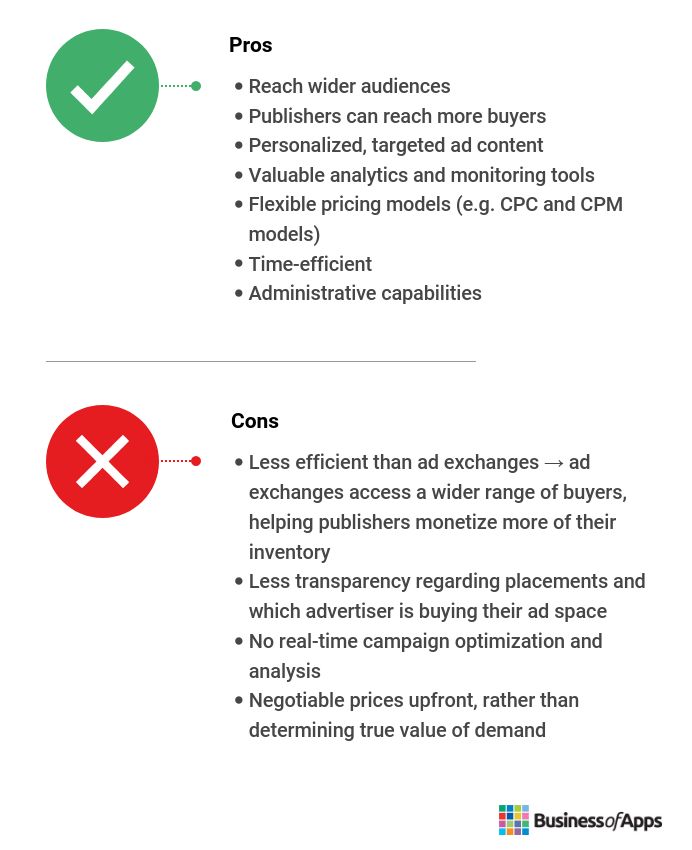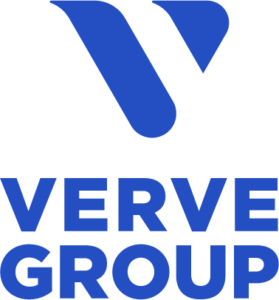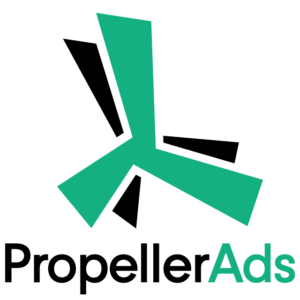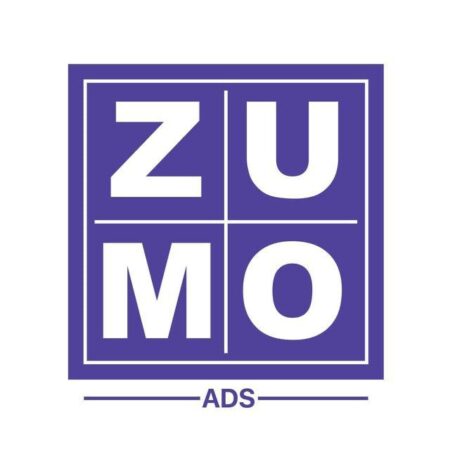One of the most profound shifts in the ad industry is that mobile apps have become a major inventory for ads to be displayed in, replacing the traditional mobile web. Mobile ad networks were then launched to serve as a handy tool of the ad tech field.
With mobile being responsible for almost half of web traffic, generating 54.4% in the fourth quarter of 2021 alone, developers and advertisers want to take advantage of ad networks to target relevant audiences and scale their ad buys efficiently.
Ad networks are diverse and finding the most suitable and reliable format for mobile apps with specific niches can be a challenge. We have therefore compiled a list of the top ad networks along with a guide that provides a full breakdown of how ad networks work and what business models they offer.
What is a mobile ad network?
The mobile advertising industry landscape consists of two major parts – supply, which is presented by publishers and a Supply Side Platform (SSP), which aggregates mobile inventory across hundreds of thousands of publishers. Demand, on the other hand, is presented by a Demand Side Platform (DSP), which allows advertisers to place mobile ads on publishers’ desktop or mobile inventory.
A mobile ad network function is to therefore serve as a middle point between these two ends of the value chain, moving inventory across both supply and demand, either directly or via reselling or re-broking of inventory.
In essence, ad networks retrieve available inventories, meaning ad spots, from a publisher and sell them to advertisers and app developers who are looking to monetize or grow their apps. They have access to inventory of several relevant publishers, instead of them having to contact publishers individually.
This way, top ad networks help advertisers boost their buys, providing a comprehensive overview of the diverse and complex digital landscape, while also offering efficient monitoring and tracking support of ad campaign performance.
Publisher dynamics aren’t limited to mobile traffic delivery and providing performance stats either. More often than not, when an advertiser’s budget is high, ad networks get involved in the ad creatives production.
For instance, in the case of video ads, ad networks can substantially improve advertisers’ ad campaign efficiency and increase its revenue significantly.
Most importantly, choosing the right mobile ad network for your campaign will ensure that you receive the right advertising option that brings you revenue by showing relevant ads that are of value to your target users.
Top Mobile Ad Networks
The top mobile ad networks
Mobile ad networks are platforms that connect advertisers with publishers who want to monetize their apps by displaying ads. Mobile ad networks enable advertisers to reach their target audience by displaying ads on apps that are relevant to their products or services.
These networks use various targeting techniques to display ads to the right audience, including demographic, geographic, and even behavioral targeting.
We’ve listed the best mobile ad networks below.
1. PropellerAds

The platform allows advertisers to reach their target audience through advanced targeting options such as geo-targeting, device targeting, and more. On the other hand, publishers can take advantage of their high eCPMs, flexible payment terms, and real-time reporting to maximize their earnings.
Overview
PropellerAds was founded in 2011 and is headquartered in Limassol, Cyprus.
The company has grown to become one of the largest ad networks in the world, serving over 1 billion ad impressions per day to users in over 195 countries. They have won several awards for their innovative ad formats and exceptional customer service.
Services
PropellerAds provides its customers with the following services:
- Advanced targeting options such as geo-targeting, device targeting, and fraud prevention measures to ensure high-quality traffic
- A variety of ad formats, including pop-unders, push notifications, native ads, and display ads
- Real-time reporting and analytics to help optimize campaigns (and maximize ROI), as well as dedicated account managers to provide personalized support
2. AdMaven

For advertisers, AdMaven offers advanced targeting options such as geo-targeting, device targeting, and more, as well as real-time reporting and analytics to help optimize campaigns.
For publishers, AdMaven offers high eCPMs and competitive payouts, as well as a variety of ad formats, including pop-unders, push notifications, and native ads.
Overview
AdMaven was founded in 2015 and is headquartered in Tel Aviv, Israel. The company serves over 15 billion ad impressions per month to users in over 200 countries.
AdMaven has become a popular choice for both advertisers and publishers looking to achieve their advertising goals.
Services
AdMaven provides its customers with the following services:
- A variety of ad formats, including pop-unders, push notifications, and native ads with real-time reporting and analytics
- Fraud prevention measures to ensure high-quality traffic and protect against prevalent ad fraud
- Dedicated account managers to provide personalized support and help with campaign setup and management
3. AdsCompass

For advertisers, they offer advanced targeting options as well as critical fraud prevention measures to ensure high-quality traffic and protection against ad fraud.
For publishers, AdsCompass offers competitive payouts as well as a variety of ad formats, including pop-unders, push notifications, and native ads. They also provide real-time reporting (and analytics) to track performance and optimize ad placements.
Overview
AdsCompass was founded in 2013 and is headquartered in Limassol, Cyprus. The company has established a strong presence over the years and serves users in over 200 countries.
The company has received positive feedback from clients and industry experts for its ad formats, advanced targeting options, and customer service.
Services
AdsCompass provides its customers with the following services:
- Ad exchange platform with real-time bidding (RTB), with the option to integrate with SSP and DSP
- Create and edit ad campaigns with the easy-to-use and intuitive dashboard
- A dedicated support team that’s available every day of the week
4. Verve Group

Verve Group’s programmatic advertising platform allows brands to reach their target audience through advanced targeting options such as geo-targeting and device targeting, and they offer a variety of ad formats, including display ads, video ads, and native ads.
Overview
Verve Group was founded in 2005 as a mobile advertising company named Verve Wireless. Over the years, the company has expanded its offerings beyond mobile advertising to become a full-service advertising and marketing company and changed its name to Verve Group in 2020 to better reflect its diverse range of services.
Verve Group is headquartered in New York City and has offices in San Diego, San Francisco, London, and Munich.
Services
Verve provides its customers with the following services:
- A network of over 20,000 influencers across various social media platforms
- Advanced targeting options such as geo-targeting and device targeting, and ad formats including display ads, video ads, and native ads
- A network of trusted publishers and affiliates to help brands reach new audiences and drive conversions
5. Adlane

They are known for their exceptional customer service and support and offer real-time reporting and analytics to track performance and optimize ad placements. They also provide dedicated account managers to provide personalized help with your ad placement and optimization.
Overview
Adlane was founded in 2018 as a self-service advertising network that aimed to provide comprehensive and industry-leading tech for website monetization.
Since then, the company has gone from strength to strength and now serves thousands of clients worldwide.
Services
Adlane provides its customers with the following services:
- Account managers who provide personalized support and help with ad placement and optimization
- A variety of ad formats, including display ads, video ads, native ads, and more
- Real-time reporting and analytics to help optimize campaigns and maximize ROI
6. Mobmio

Their expertise in mobile marketing and partnerships allows them to filter partners and traffic, and they provide a worldwide mobile advertiser list with high payouts. App promotion via the CPI/CPL/CPA/revenue share models is also available.
Overview
Mobmio was founded in 2022 by Aleksandr Kryvosheiev, who brings a wealth of experience to the role, as well as a proven track record of delivering results and driving organizational growth.
Mobmio grew out of a mobile app service provided by partner network Admitad. They served over 500 million mobile users in their first year alone, with over 50 million interactions.
Services
Mobmio provides its customers with the following services:
- Fast and flexible integration through popular trackers with CPI/CPL/CPA/revenue share mechanics
- Quality control and brand-bidding protection with wide geo mobile offers
- Dedicated publisher relation manager and flexible payments
Why are app ad networks important?
For publishers, networks can be an important part of their monetization strategy, as ad networks help publishers sell their inventory. And with in-application advertising emerging as a prime form of mobile advertising in the marketing world, app ad network platforms are equally growing in importance.
One of the most profound shifts in the mobile ad industry is that mobile apps have become the major inventory for ads to be displayed in, replacing traditional mobile web. And the reason behind this transition is simply that most people spend their time browsing through their mobile devices, using apps instead of the web like they used to do.
With the number of mobile apps that continues to increase exponentially, in-app advertisements have the potential to replace mobile web ads completely. Today, all of the highest paying mobile ad networks are laser-focused on mobile as the fastest growing digital advertising sector.
And as the mobile advertising industry continues to grow, it becomes more apparent that moving all operations into the online programmatic area is the only way to go. This way, you will be able to accommodate far greater advertising volumes, allowing the increasing number of advertisers to manage their ad campaigns efficiently, and mobile publishers to maximize their inventory monetization.
The downside of the programmatic approach, however, is that it produces lower engagement rates and may even expose advertisers to a higher risk of ad fraud. While mobile advertising is more relevant compared to manual ad campaigns, it can even be harmful for brands in cases where their ads are occasionally being placed on websites that contain questionable content.
Nonetheless, the trend of advertising automation continues at a steady pace, and Artificial Intelligence (AI) algorithms are praised as the new way to tackle multiple challenges that digital advertising faces. In fact, AI is the technology that many industries embrace to handle big data volumes and help them gain valuable insights, all the while increasing its efficiency.
Pros & cons of ad networks
Before you choose the top ad network for your business, let us dissect the advantages and disadvantages of the concept. This will allow you to make a more informed decision when selecting from our list of the best ad networks in the industry.
Ad Networks – Pros & Cons
Now, before we start profiling the top mobile ad networks, let us take a look at how mobile ad networks typically work and identify the different categories and layers that describe a mobile ad network.
How do ad networks work?
In essence, mobile ad networks are designed to buy and sell inventory from various mobile publishers, segmenting these inventories based on demographics and selling the categorized impressions to advertisers who are looking for similar impressions.
As we mentioned earlier, ad networks conveniently offer a wide range of pricing models that include cost-per-click (CPC), cost-per-acquisition (CPA), and cost-per-thousand impressions (CPM).
Moreover, there are several types of business models to run your ad campaigns on as well as a variety of ad formats and targeting strategies. Understanding the depths of ad networks will allow you to identify the top ad network that will work for your unique mobile app.
Mobile advertising business models
All mobile ad networks provide users with several types of business models to run ad campaigns with. There are 5 major types – CPM, CPC, CPI, CPA and CPV.
With CPM (cost-per-mile) type, an advertiser is charged each time her or his ads are shown 1,000 times (so-called ‘a mile’). It’s the best business model for publishers, because it allows to make money every time an ad was displayed. If they have a stable predictable traffic, it allows publishers to forecast their revenue. The down side is that they may loose some extra revenue, if their app or website audience is really interested in a product or service they advertise. For that case CPC model would allow them to make more money.
With CPC (cost-per-click) model an advertiser is charged for each click made on her or his mobile ads. This model works better for advertisers, because it allows them to pay only for instances when an interest to their product or service is explicit (their ads were clicked) and, as mentioned above, in some cases may work for publishers as well. For a publisher this model always presents a certain risk of him serving lots of ad impressions for free.
CPI (cost-per-install) model implies that advertisers are charged only when a click on their ads resulted into an actual mobile app install. It’s a specific case of a more generic CPC business model. Cost-per-install price has become one of the most important metrics for mobile app marketers to measure and keep track of, because essentially it represents a price they pay to acquire customers and hence it should be factor into ROI calculations.
CPA (cost-per-action) type is more advanced version of CPI, when an advertiser is charged for specific action (in-app sale, subscription, form submit, sign up and more) users take inside an app that is advertised on a mobile ad network. This type of a business model presents more opportunities for publishers to monetize their inventory on one hand and more options for advertisers to grow their business on the other.
And finally CPV (cost-per-view) type is applicable to mobile ad networks that provide advertisers with video ad campaigns. With this model, advertisers are charged for each instance their video mobile ad was viewed. With the current pace of a video advertising growth, this model becomes more and more popular.
Mobile ad formats
There are 5 major formats supported by top mobile ad networks – interstitial, banner ads, native ads, video ads and offer wall.
Interstitial ads
A full screen ads that cover the interface of their host application. This mobile ad format is most frequently used to display an ad between different app screens and it’s quite often displayed between different levels in a mobile game app.
Banner ads
A classical static or animated image ad, which is placed inside an app’s interface. Such ad may advertise a third party product, other digital or physical goods, as well as an option to expand an app’s functionality.
Native ads
Either a banner image or video ad that matches the form and function of the app interface it’s displayed in. The core concept of native ads to mimic an app’s interface to be least intrusive compared to other ad formats.
OfferWall ads
It is an ad unit within a mobile app that provides end users with lots of offers to engage with. The most frequent use case is mobile games, where offerwalls may either advertise third party games or a series of games from the same game developer.
Video ads
Video ads consist of a short, usually up-to 60 seconds, video clip to advertise products and services. This mobile ad format is most often used within media apps. There are two major types of video ads – in-stream and out-stream. With in-stream type, video ads are displayed full-screen before, after and within video content that is streamed inside an app. With out-stream type video ads are displayed on a web page, displayed inside a mobile app.
Mobile ads reporting
An advertising campaign performance data reporting is one of the key components that is crucial for its success. This information is provided by mobile ad networks to advertisers via an online dashboard. It includes data on such parameters of ads performance as number of impressions, clicks, installs, video ad views, platform, country, ad format and so on.
Mobile ads targeting
There are number of parameters that allow to narrow down a mobile ad campaign reach to a specific audience. These parameters are called targeting options, there are a number of such options but the majors are the following:
Geo
It allows to narrow down an ad campaign within a specific country or region. It enables mobile marketers to advertise a product or service that is relevant only within a specific region.
Device
It allows to show ads on specific models of mobile devices only. This type of targeting lets advertisers to display ads on devices with a specific screen size and other hardware requirements, which allows to avoid a mobile ad experience degradation.
Carrier
With this option, it’s possible to show ads only to mobile users, who are served by a specific mobile carrier. It presents advertisers an opportunity to display ads to mobile users, those mobile carrier provides a better mobile signal reception in a specific area.
OS
it allows to show ads on mobile devices running specific operating system or even particular versions of OS. It gives advertisers a benefit of displaying ads to mobile users on devices that are best to display those ads software wise.
Connection
By applying this targeting option, it’s possible to show mobile ads on mobile devices when they are connected to the Internet either via Wifi or 3G/LTE connection.
Interests
mobile ad network that collect mobile users data and build their profile allows to narrow down an ad campaign on an audience segment with specific interests only.
Gender
This option allows to narrow down an ad campaign to mobile users of a particular gender. Naturally, just like with any kind of advertising such targeting is aimed to market goods specifically to females and males.
How to choose the best ad network?
A successful ad network strategy looks different to individual publishers and advertisers. It will depend on the unique factors of a business’ needs, including the type of inventory, audience location and business size.
But one thing remains the same amongst all publishers looking to partner with a mobile ad network: The best network should serve quality and relevant ads to audiences within your mobile app business. And publishers and advertisers will usually use an ad network together with other digital advertising components, such as DSPs and ad exchanges.
With a sea full of different mobile ad platforms, it can be a challenge to find one that will give your in-app advertising the boost it needs. So when deciding on a top mobile ad network for your app, there are some factors to consider to ensure you pick the best one that offers good rates, a variety of ad formats, high eCPMs as well as efficient audience targeting.
While there are many things you need to consider when partnering with an ad network, there are a few key points to prioritize when making your decision:
- Targeting capabilities
- Price model, including compensation & payment terms
- Ad formats
- Support provided
- Ad quality
- Ratings of advertiser network
Partner with top ad networks
Mobile ad networks have surely revolutionized the app advertising industry, along with key ad tech players, including the ad exchange, DSPs and SSPs, providing advertisers and publishers the opportunity to effectively target relevant users and increase ROI.
In order to facilitate the process of navigating through the broad advertising landscape, ad networks enable cost-effective ways to buy ad space, surpassing the traditional advertising of manually contacting advertisers and driving automation and their technological advantages with their capabilities.
Take a look at our list of top mobile ad networks for app developers and mobile business owners, and find the right one to work with. To compile this list, we researched the major players in the mobile advertising field, including companies that offer a wide range of ad formats and targeting options, as well as robust statistics and good technical support.


























